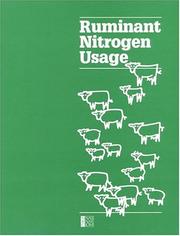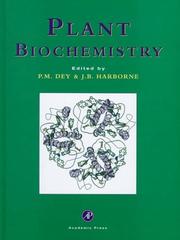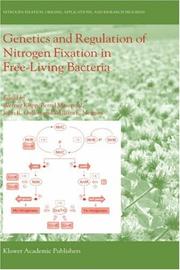| Listing 1 - 10 of 12 | << page >> |
Sort by
|

ISBN: 030903597X 9786610222018 1280222018 0309568013 9780309568012 9780309035972 Year: 1985 Publisher: Washington, D.C. : National Academy Press,
Abstract | Keywords | Export | Availability | Bookmark
 Loading...
Loading...Choose an application
- Reference Manager
- EndNote
- RefWorks (Direct export to RefWorks)
Ruminant --- ruminants --- Métabolisme de l'azote --- Nitrogen metabolism --- Nitrogen in animal nutrition. --- Ruminants --- Feeding and feeds. --- Animal nutrition

ISBN: 9780122146749 0122146743 9780080525723 0080525725 1281024945 9781281024947 0127992146 9780127992143 9786611024949 Year: 1997 Publisher: San Diego Academic Press
Abstract | Keywords | Export | Availability | Bookmark
 Loading...
Loading...Choose an application
- Reference Manager
- EndNote
- RefWorks (Direct export to RefWorks)
Presenting the topic in a concise and simplified manner, this edition provides an overview of the entire field of plant biochemistry. It covers issues such as photosynthesis and the commercial applications of genetic engineering, as well as including research findings through to the end of 2003.
Botanical chemistry --- PLANTS --- PLANT BIOCHEMISTRY --- METABOLIC PROCESSES --- METABOLISM --- plantensamenstelling --- plant composition --- plantenfysiologie --- plant physiology --- plantkunde --- botany --- genetische modificatie --- genetic engineering --- recombinant dna --- fotosynthese --- photosynthesis --- Plant Biochemistry, Phytochemistry --- Plantenbiochemie, fytochemie --- Botanical chemistry. --- Plants --- Metabolism. --- PLANT CELLS --- PHOTOSYNTHESIS --- NUCLEIC ACIDS --- PROTEINS --- PHENOLIC COMPOUNDS --- ISOPRENOIDS --- PLANT PATHOLOGY --- PLANT ECOLOGY --- REVIEWS --- MOLECULAR BIOLOGY --- CARBOHYDRATE METABOLISM --- LIPID METABOLISM --- NITROGEN METABOLISM --- GENE EXPRESSION --- GENETIC REGULATION --- BIOCHEMISTRY --- BIOTECHNOLOGY
Book
Year: 2020 Publisher: Basel, Switzerland MDPI - Multidisciplinary Digital Publishing Institute
Abstract | Keywords | Export | Availability | Bookmark
 Loading...
Loading...Choose an application
- Reference Manager
- EndNote
- RefWorks (Direct export to RefWorks)
The appearance of the new generation in higher plants is ensured by the presence of viable seeds in the mother plant. A good number of signaling networks is necessary to provoke germination. Phytohormones play a key role in all stages of seed development, maturation, and dormancy acquisition. The dormancy of some seeds can be relieved through a tightly regulated process called after-ripening (AR) that occurs in viable seeds stored in a dry environment. Although ABA is directly involved in dormancy, recent data suggest that auxin also plays a preponderant role. On the other hand, the participation of reactive oxygen species (ROS) in the life of the seed is becoming increasingly confirmed. ROS accumulate at different stages of the seed’s life and are correlated with a low degree of dormancy. Thus, ROS increase upon AR and dormancy release. In the last decade, the advances in the knowledge of seed life have been noteworthy. In this Special Issue, those processes regulated by DOG1, auxin, and nucleic acid modifications are updated. Likewise, new data on the effect of alternating temperatures (AT) on dormancy release are here present. On the one hand, the transcriptome patterns stimulated at AT that encompasses ethylene and ROS signaling and metabolism together with ABA degradation were also discussed. Finally, it was also suggested that changes in endogenous γ-aminobutyric acid (GABA) may prevent seed germination.
chestnut --- GABA --- seed germination --- carbon metabolism --- nitrogen metabolism --- DOG1 --- seed dormancy --- ABA --- ethylene --- clade-A PP2C phosphatase (AHG1 --- AHG3) --- after-ripening --- asDOG1 --- heme-group --- association mapping --- climate adaptation --- germination --- genomics --- legumes --- Medicago --- plasticity --- physical dormancy --- DNA methylation --- oxidation --- RNA stability --- seed vigour --- ROS --- primary dormancy --- ABI3 --- auxin --- YUC --- PIN --- ARF --- endosperm --- integuments --- AGL62 --- PRC2 --- RNA-Seq --- dormancy termination --- gene expression --- antioxidants --- ethylene signaling --- environmental signals --- long-lived mRNA --- monosomes --- auxin and ABA --- alternating temperatures

ISBN: 9781402021787 140202178X 9781402021794 9786610460649 1280460644 1402021798 Year: 2004 Volume: 2 Publisher: Dordrecht ; Boston : Kluwer Academic Publishers,
Abstract | Keywords | Export | Availability | Bookmark
 Loading...
Loading...Choose an application
- Reference Manager
- EndNote
- RefWorks (Direct export to RefWorks)
Genetics and Regulation of Nitrogen-Fixing Bacteria This book is the second volume of a seven-volume series, which covers all fields of research related to nitrogen fixation - from basic studies through applied aspects to environmental impacts. Volume II provides a comprehensive and detailed source of information concerning the genetics and regulation of biological nitrogen fixation in free-living prokaryotes. This preface attempts to provide the reader with some insight into how this volume originated, how it was planned, and then how it developed over the several years of its production. Once the editorial team was established, the first job was to decide which of the many free-living diazotrophs that have been subjected to genetic analysis should be included in this volume. Would we need to develop specific criteria for selection or would the organisms, in effect, select themselves? Of course, Klebsiella pneumoniae and Azotobacter vinelandii, which have served (and still serve) as the main model organisms for the genetic analysis of diazotrophy, plus some of the other bacteria described in this volume, did indeed select themselves. However, there was considerable discussion surrounding well-characterized fixing species, like Azorhizobium caulinodans and Herbaspirillum seropedicae, both of which are able to fix atmospheric N under free-living conditions.
Nitrogen-fixing microorganisms. --- Nitrogen --- Bacterial genetics. --- Micro-organismes fixateurs d'azote --- Azote --- Génétique bactérienne --- Fixation. --- Metabolism --- Fixation --- Métabolisme --- Bacteria --- Fixation de l'azote --- Nitrogen fixation --- Klebsiella --- Clostridium --- Code génétique --- genetic code --- Écologie microbienne --- microbial ecology --- Molybdène --- Molybdenum --- Nitrogen -- Fixation. --- Nitrogen -- Metabolism -- Regulations. --- Nitrogen-fixing microorganisms --- Bacterial genetics --- Microbiology & Immunology --- Biology --- Health & Biological Sciences --- Regulation --- Regulation. --- Microbiology. --- Microbial genetics. --- Microbial genomics. --- Bacteriology. --- Soil conservation. --- Microbial Genetics and Genomics. --- Soil Science & Conservation. --- Conservation of soil --- Erosion control, Soil --- Soil erosion --- Soil erosion control --- Soils --- Agricultural conservation --- Soil management --- Microbiology --- Genomics --- Microbial genetics --- Microorganisms --- Genetics --- Microbial biology --- Control --- Prevention --- Conservation --- Soil science. --- Pedology (Soil science) --- Agriculture --- Earth sciences --- Archaea
Book
Year: 2021 Publisher: Basel, Switzerland MDPI - Multidisciplinary Digital Publishing Institute
Abstract | Keywords | Export | Availability | Bookmark
 Loading...
Loading...Choose an application
- Reference Manager
- EndNote
- RefWorks (Direct export to RefWorks)
This Special Issue is a collection of research articles focused on the production and role of nitric oxide in plants. Nitric oxide is a crucial molecule used in the orchestration of cellular events in animals and plants. With a mixture of primary research papers and review articles written by some of the top researchers in the field, this work encompasses many aspects of this important and growing area of biochemistry.
catalase --- monodehydroascorbate reductase --- tyrosine nitration --- nitric oxide --- peroxisome --- reactive oxygen species --- S-nitrosation --- superoxide dismutase --- antioxidants --- hydrogen gas --- hydrogen peroxide --- hydrogen sulfide --- S-nitrosothiols --- S-nitrosoglutathione reductase --- S-(hydroxymethyl)glutathione --- nitrate reductase --- NOFNiR --- nitrogen metabolism --- NIA1 --- NIA2 --- nitrite --- nitrate --- methyl viologen --- benzyl viologen --- NO analyzer --- molybdenum cofactor --- Arabidopsis thaliana --- nitro-fatty acids --- nitroalkenes --- nitroalkylation --- electrophile --- nucleophile --- signaling mechanism --- post-translational modification --- reactive lipid species --- nitro-lipid-protein adducts --- Trebouxia --- microalgae --- lipid peroxidation --- diaphorase activity --- lichens --- nitric oxide synthase --- nitrogen dioxide --- plant growth --- cell enlargement --- cell proliferation --- early flowering --- PsbO --- nitric oxide homeostasis --- cue1/nox1 --- reactive nitrogen species --- germination --- root development --- stress responses --- sugar metabolism --- nitration --- S-nitrosylation --- SNO-reductase --- thiol modification
Book
Year: 2020 Publisher: Basel, Switzerland MDPI - Multidisciplinary Digital Publishing Institute
Abstract | Keywords | Export | Availability | Bookmark
 Loading...
Loading...Choose an application
- Reference Manager
- EndNote
- RefWorks (Direct export to RefWorks)
Polyamines are small organic compounds found in all living organisms. In recent years, there have been many exciting advances in our understanding of plant polyamines, such as the determination of the biosynthetic and catabolic pathways of plant polyamines and the identification of the roles that plant polyamines play in cellular processes. This Special Issue contains six original research papers and three review articles, providing valuable insights and information for future polyamine-related research.
polyamine oxidase --- norspermidine --- thermospermine --- Selaginella lepidophylla --- Arabidopsis thaliana mutant --- polyamines --- spermidine --- nonsense-mediated decay --- no-go decay --- non-stop decay --- quality control --- translation --- copper amine oxidases --- H2O2 --- ROS --- ABA --- stomatal closure --- back conversion pathway --- polyamine catabolism --- stress response --- terminal catabolism pathway --- Ranunculus biternatus --- Ranunculus pseudotrullifolius --- Ranunculus moseleyi --- secondary metabolite variation --- amines --- quercetins --- natural populations --- environment --- redundancy --- sub-Antarctic plants --- Arabidopsis --- phloem --- rice --- spermine --- xylem --- nitrogen metabolism --- abiotic and biotic stress --- hydrogen peroxide --- antioxidant machinery --- heat shock proteins --- heat stress --- polyamine oxidases --- PA acetylation --- PA oxidation --- PA back-conversion --- putrescine --- tomato --- spermidine synthase --- fruit shape --- cell division --- cell expansion --- copper amine oxidase
Periodical
ISSN: 18732763 Year: 1985 Publisher: Elmsford, NY : Pergamon,
Abstract | Keywords | Export | Availability | Bookmark
 Loading...
Loading...Choose an application
- Reference Manager
- EndNote
- RefWorks (Direct export to RefWorks)
Bones --- Bone --- Metabolism --- Os --- Bone Diseases, Metabolic. --- Osteology --- Metabolic Bone Diseases --- Osteopenia --- Bone Disease, Metabolic --- Disease, Metabolic Bone --- Diseases, Metabolic Bone --- Metabolic Bone Disease --- Osteopenias --- Physiology --- Pathophysiology --- Diseases --- Physiologie --- Périodiques. --- Physiopathologie --- Maladies --- Diseases. --- Pathophysiology. --- Physiology. --- Musculoskeletal system --- Skeleton --- Bone Diseases, Metabolic --- Low Bone Density --- Low Bone Mineral Density --- Bone Density, Low --- Low Bone Densities --- anabolism --- catabolism --- biochemistry --- physiology --- biocatalysis --- biosynthesis --- carbohydrate metabolism --- carbon metabolism --- catabolite repression --- copper metabolism --- dealkylation --- energy metabolism --- hormone metabolism --- lipid metabolism --- metabolic detoxification --- metabolic sequestration --- mineral metabolism --- nitrogen metabolism --- pharmacokinetics --- protein metabolism --- steroid metabolism --- vitamin metabolism --- water metabolism --- metabolic flux analysis --- metabolic studies --- metabolites --- metabolome --- metabolomics --- oxidative stress --- connective tissues --- musculoskeletal system --- bone density --- bone marrow --- bone types --- clavicle --- epiphyses --- sternum --- bone health --- renal osteodystrophy --- bone transplantation --- Bone Diseases, Metabolic, --- bones --- metabolism
Book
Year: 2022 Publisher: Basel MDPI - Multidisciplinary Digital Publishing Institute
Abstract | Keywords | Export | Availability | Bookmark
 Loading...
Loading...Choose an application
- Reference Manager
- EndNote
- RefWorks (Direct export to RefWorks)
This book contains a collection of recent peer-reviewed articles on the topic "Crop Adaptation to Elevated CO2 and Temperature" published in Plants. Topics range from meta-analyses of crop responses, to descriptions and results of large-scale screening efforts, to molecular studies of changes in gene expression related to fruit quality.
adaptation --- breeding --- CO2 --- CWR --- seed yield --- goji berry --- sugar metabolism --- elevated CO2 --- functional domain --- gene cloning and expression --- Lens culinaris --- climate change adaptation --- root development --- root depth distribution --- climate change --- heat stress --- nitrogen assimilation --- nitrogen metabolism --- nitrogen uptake --- Solanum --- tomato --- warming --- Solanum tuberosum --- tuber --- sink organ --- ambient temperature --- cell proliferation --- grain quality --- cereals --- yield and quality --- high [CO2] --- predicted future climate --- high temperature --- grain quality traits --- drought stress --- Genovese cultivar --- photosynthesis --- stomatal conductance --- chlorophyll --- carotenoids --- antioxidant defense metabolites --- early growth stage --- ethylene --- IAA conjugates --- indole-3-acetic acid --- invasiveness --- lupine seedlings --- simulated conditions --- warming simulation --- grain yield --- biomass --- bread wheat --- genotypes --- barley --- CO2 enrichment --- Hordeum vulgare L. --- water-use efficiency --- yield --- gravitropic angle of curvature --- initial root --- lateral root number --- primary root --- root system architecture --- simulated warming --- n/a
Periodical
Abstract | Keywords | Export | Availability | Bookmark
 Loading...
Loading...Choose an application
- Reference Manager
- EndNote
- RefWorks (Direct export to RefWorks)
Cell metabolism --- Cells --- Metabolic Diseases --- Homeostasis --- metabolism --- Metabolic Diseases. --- Homeostasis. --- Cellules --- Cell metabolism. --- Métabolisme cellulaire. --- metabolism. --- Métabolisme --- Autoregulation --- Diseases, Metabolic --- Thesaurismosis --- Disease, Metabolic --- Metabolic Disease --- Thesaurismoses --- Metabolism --- Cell --- Cell Biology --- Cellular control mechanisms --- Métabolisme cellulaire. --- Métabolisme --- Cytology --- cells. --- metabolic diseases. --- homeostasis. --- biochemistry --- physiology --- anabolism --- biocatalysis --- biosynthesis --- carbohydrate metabolism --- carbon metabolism --- catabolism --- catabolite repression --- copper metabolism --- dealkylation --- energy metabolism --- hormone metabolism --- lipid metabolism --- metabolic detoxification --- metabolic sequestration --- mineral metabolism --- nitrogen metabolism --- pharmacokinetics --- protein metabolism --- steroid metabolism --- vitamin metabolism --- water metabolism --- metabolic flux analysis --- metabolic studies --- metabolites --- metabolome --- metabolomics --- oxidative stress --- cell biology --- acinar cells --- adipocytes --- aleurone cells --- antigen-presenting cells --- bacteriocytes --- blood cells --- bone marrow cells --- bundle sheath cells --- chondrocytes --- chromaffin cells --- chromatophores --- coelomocytes --- cultured cells --- endothelial cells --- epithelial cells --- eukaryotic cells --- fibroblasts --- germ cells --- giant cells --- gonadotropic cells --- granulosa cells --- guard cells --- hemocytes --- hepatocytes --- islets of Langerhans --- keratinocytes --- kidney cells --- Leydig cells --- luteal cells --- mast cells --- myocytes --- neoplasm cells --- neurosecretory cells --- nurse cells --- osteoblasts --- osteoclasts --- phagocytes --- plant root cells --- prokaryotic cells --- Schwann cells --- Sertoli cells --- somatic cells --- splenocytes --- spores --- stem cells --- stromal cells --- tenocytes --- teratocytes --- thecal cells --- vegetative cells --- artificial cells --- cell transplantation --- cell viability --- cellular microenvironment --- physiological regulation --- autoregulation --- glucagon-like peptide 2 --- glucoregulation --- glucose tolerance tests --- metabolic disorders --- noninfectious diseases --- acidosis --- alkalosis --- calcinosis --- carbohydrate metabolism disorders --- dehydration (animal physiology) --- developmental orthopedic disease --- diabetes --- hypercalcemia --- hyperinsulinemia --- hyperkalemia --- hyperketonemia --- hypocalcemia --- hypokalemia --- hypomagnesemia --- hyponatremia --- inherited metabolic diseases --- iron overload --- ketonemia --- ketonuria --- lipid metabolism disorders --- osteomalacia --- refeeding syndrome --- uremia --- malnutrition --- Metabolisme cel·lular --- Citologia --- Homeòstasi
Book
Year: 2021 Publisher: Basel, Switzerland MDPI - Multidisciplinary Digital Publishing Institute
Abstract | Keywords | Export | Availability | Bookmark
 Loading...
Loading...Choose an application
- Reference Manager
- EndNote
- RefWorks (Direct export to RefWorks)
Ecophysiological mechanisms underlie plant responses to environmental conditions and the influence these responses have on ecological patterns and processes. In this Special Issue, with a particular interest in the interactions between climate change, environmental disturbance, and functional ecology, experimental observations are described at a range of spatial scales. A modeling framework is used in an effort to relate mechanistic responses to ecosystem functions and services, and link forest ecophysiology and environmental indicators. This Special Issue collects important advances in studying and monitoring plant–environment interactions, covering biogeographic gradients from Mediterranean woodlands to boreal forests and from Alpine mountains to tropical environments.
Leaf δ13C --- Leaf δ15N --- Growth stage --- Environmental factors --- Relative importance --- nitrogen dioxide --- nitrogen metabolism --- photorespiration --- heat dissipation --- excess absorbed light energy --- electron transfer --- photochemical efficiency --- altitude --- non-structural carbohydrates --- nutrients --- ontogeny --- Pinus cembra L. --- Larix decidua Mill --- boreal forest --- leaf temperature --- photosynthesis --- water availability --- leaf thermal damage --- thermoregulation --- endangered --- Sonneratia × hainanensis --- reproductive system --- seed germination --- light --- temperature --- salinity --- Cinnamomum migao --- autotoxicity --- seedling growth --- soil substrate --- soil enzyme --- soil fungi --- TreeSonic --- MOEd --- forest productivity --- dendrochronology --- recruitment period --- Aspromonte National Park --- Sessile oak --- deciduous forest --- carbon sequestration --- wood density --- allometry --- functional traits --- climate niches --- Malus baccata --- MbERF11 --- cold stress --- salt stress --- transgenic plant --- dendrometer --- stem circumference changes --- climate response --- Mediterranean --- Pinus nigra --- Pinus pinaster --- ontogenetic phases --- adaptive strategies --- leaf functional traits --- light environment --- canopy tree species --- carbon isotopes --- climate change --- respiration --- discrimination --- mixed forest --- keeling plot --- branch lifespan --- shoot lifespan --- stem lifespan --- branch shedding --- shoot shedding --- stem shedding --- canopy --- crown development --- tree architecture --- light foraging --- phenotypic plasticity --- shade tolerance --- shade acclimation --- light acclimation --- light regime --- sunfleck --- leaf thickness --- leaf angle --- leaf three-dimensional structure --- n/a
| Listing 1 - 10 of 12 | << page >> |
Sort by
|

 Search
Search Feedback
Feedback About UniCat
About UniCat  Help
Help News
News